Waldgärten sind einer jungen Waldgesellschaft nachempfundene Pflanzengemeinschaften mit überwiegend essbaren Bäumen, Sträuchern, Kräutern und Wildgemüsen. Eine Vielzahl an unterschiedlichen Wuchsformen wird dabei auf die bestmöglichste Art und Weise kombiniert, um die Bodenfruchtbarkeit zu verbessern, ein lokales Kleinklima zu schaffen und mit dem geringstmöglichen Arbeits- und Maschinenaufwand den besten Nutzen zu erzielen.
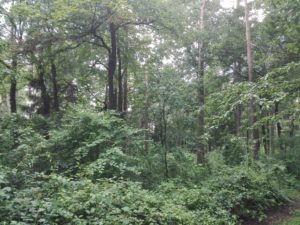
Ein junger Mischwald im unteren Traisental – so ähnlich könnte die Umgebung für die erste Waldgartengestaltung unserer Vorfahren ausgesehen haben.
Waldgärten sind mit großer Wahrscheinlichkeit schon so alt wie die Menschheit selbst. Aus anthropologischen Quellen wissen wir, dass sich unsere Vorfahren in savannenähnlichen Landschaften entwickelten, die ihre biologischen Grundbedürfnisse am besten befriedigen konnten. Ein lockerer Baumbestand inmitten fruchtbaren Graslandes bot zugleich reichlich Nahrung und Schutz.
Über viele Jahrtausende verbrachte die Menschheit als Jäger und Sammler und schuf einen großen Wissens- und Erfahrungsschatz hinsichtlich der Nutzbarkeit von Pflanzen. Es ist anzunehmen, dass die Menschen mit dem Übergang zur Sesshaftigkeit auch die Fähigkeit zur Pflanzenvermehrung praktizierten und in den ausgewählten Landschaften jene Pflanzen zu kultivieren begannen, die sie aus ihrer Entwicklungsgeschichte heraus bereits kannten. Auch wenn dieser Aspekt in der Literatur in diesem Kontext noch nicht formuliert wurde, so kann der Übergang zur Sesshaftigkeit durchaus als Beginn der Waldgartengestaltung betrachtet werden. Mit an Sicherheit grenzender Wahrscheinlichkeit pflanzten unsere Vorfahren rund um ihre ersten Siedlungen eine Vielzahl an Bäumen, Sträuchern, Kräutern und Wildgemüsen mit unterschiedlichen Wuchshöhen und dürfen somit als die Gründer/innen der Waldgartengestaltung bezeichnet werden.
Die Erfolgsgeschichte der menschlichen Evolution ist untrennbar mit ihrer Anpassungsfähigkeit verbunden. Bei der Besiedelung der Kontinente versuchten die Menschen, sich an die örtlichen und klimatischen Gegebenheiten anzupassen und schufen ganz spezifische Waldgartensysteme, die sich ihrer Lebensumwelt anpassten. Noch heute finden wir dieses traditionelle Wissen in zahlreichen indigenen Kulturen auf der ganzen Welt.
Die Waldgartengestaltung hat darüber hinaus auch einen bedeutenden sozialen Aspekt. Ärmere Bevölkerungsgruppen schufen mit einzelnen Waldgartensystemen auf kleinster Fläche eine enorme Produktivität, die ihre Ernährung und damit auch ihr Überleben sicherte.
Gegenwärtig werden rund 80 % der landwirtschaftlichen Nutzfläche auf der Welt von Kleinbäuerinnen und Kleinbauern bewirtschaftet. Der Großteil von ihnen wirtschaftet nach traditionellen Anbaumethoden. Die weltweiten Erfahrungen aus dem Bereich der Waldgartengestaltung können dazu beitragen, kleinbäuerliche Strukturen zu bewahren und in ihrer wirtschaftlichen Existenzgrundlage weiter zu entwickeln und zu verbessern.
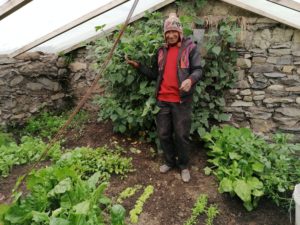
Ernesto Flores Apaza – Präsident der Nation Queros (von 2017 bis 2019) in den Anden Perus kultiviert in seinem, dem Haus angeschlossenen Gewächshaus, Gemüse auf 4.700 m Seehöhe.
Mitte der 1970er Jahre wurde auf Initiative des Kanadiers John Bene vom International Development Research Centre (IDRC) das International Council for Research in Agroforestry (ICRAF) gegründet, in dem unter Federführung der UNO Wissenschaftler/innen gemeinsam mit der lokalen Bevölkerung in nahezu allen Teilen der Welt Projekte zur Verbesserung der Waldgartensysteme initiieren und betreuen. Daraus ist ein großer Fundus an wissenschaftlichen Publikationen zu den unterschiedlichsten Themenstellungen entstanden.
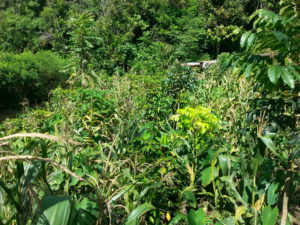
Valle Sagrale am Ufer des Rio Urubamba (Peru) – in Quellouno bewirtschaftet David mit seiner Familie einen vielfältigen Waldgarten auf ca. 3 ha. Neben der Selbstversorgung liefern die Früchte einen Großteil des Familieneinkommens.
Es verwundert daher nicht, dass auch die Permakulturbewegung nahezu zeitgleich auf das bewährte Waldgartenkonzept zurückgegriffen hat. Bill Mollison und David Holmgren entwickelten das theoretische Konzept der Permakultur und wurden dafür 1981 mit dem alternativen Nobelpreis ausgezeichnet.
Innerhalb der Permakulturbewegung gelten im Feld der Waldgartengestaltung Robert Hart und Martin Crawford als erste Pioniere, die das Waldgartenkonzept im europäischen Raum wiederentdeckt haben. An dieser Stelle soll auch noch Patrick Whitefield erwähnt werden, dessen Buch: “ Das große Handbuch Waldgarten – Biologischer Obst-, Gemüse- und Kräuteranbau auf mehreren Ebenen“ auch in deutscher Sprache erschienen ist.
Eine Liste an vielfältiger, größtenteils englischsprachiger Literatur zum Thema findet ihr im Anhang des Beitrages.
Wenn ihr Anregungen, Ergänzungen oder Kommentare zur Geschichte der Waldgärten habt, freu ich mich über eure Rückmeldungen.
Ich bin sehr dankbar dafür, Teil dieser großartigen Bewegung sein zu dürfen und wünsche euch eine gute Zeit.
Euer Waldgärtner
Reinhard
Geben wir der Natur ein Stück Land zurück.
Ausgewählte Literatur zum Thema Agroforestry:
Alvin R and Nair PKR (1985) Agroforestry practices involving agricultural plantation crops in southeast Bahia, Brazil. Agroforestry Systems (in press)
Ambar S (1982) Overview of the results of tradition alagroforestry study in Ci-Tarum river basin, West Java. Paper presented to The Regional Seminar-Workshop in Agroforestry, 18–22 October, 1982. SEARCA, College, Laguna, The Philippines
Arnold GW and de Wit CT (eds) (1976) Critical Evaluation of Systems Analysis in Ecosystem Research and Management. Centre for Agric. Pub. Docum., Wageningen, The Netherlands
Atmosoedaryo S and Wijayakusumah K (1979) Ecological aspects of agroforestry in the lowland humid tropics: Southeast Asia. In: Chandler T and Spurgeon D (eds) International Cooperation in Agroforestry, pp. 117–128. ICRAF, Nairobi
Boonkird S-A, Fernandes ECM and Nair PKR (1984) Forest villages — an agroforestry approach to rehabilitating forest lands degraded by shifting cultivation in Thailand. Agroforestry Systems 2:87–102
Bourke RM (1984) Food, coffee and Casuarina: an agroforestry system from the Papua New Guinea highlands. Agroforestry Systems 2:273–279
Buck L (ed) (1981) Proceedings of the Kenya National Seminar on Agroforestry. November, 1980. ICRAF/Univ Nairobi, Nairobi
Chandler T and Spurgeon D (eds) (1979) International Cooperation in Agroforestry. Proceedings of ICRAF/DSE Conference. ICRAF, Nairobi
Combe J and Budowski G (1979) Classifiacation of agroforestry techniques. In: de las Salas (ed) Proceedings of the Workshop on Agroforestry Systems in Latin America, pp 17–47. CATIE, Costa Rica
de las Salas G (ed) (1979) Proceedings of the Workshop on Agroforestry Systems in Latin America. CATIE, Turrialba, Costa Rica
de Wit CT and J Goudrian (1974) Simulation of Ecological Processes. Centre for Agric Pub Docum, Wageningen, The Netherlands
Evans PT and Rombold JS (1984) Paraiso (Melia azedarach var. ‘Gigante’) woodlots: an agroforestry alternative for the small farmer in Paraguay. Agroforestry Systems 2:199–214
Food and Agriculture Organization (1981a) Agroforesterie Africaine. FAO, Rome
Food and Agriculture Organization (1981b) India and Sri Lanka: Agroforestry. FAO, Rome
Felker P (1978) State of the Art: Acacia albida as a Complementary Intercop with Annual Crops. Univ California, Berkely, California (AID/afr C-1361; mimeo)
Fernandes ECM, O’Kting’ati A and Maghembe J (1984) The Chagga home-gardens: a multi-storied agroforestry cropping system in Mt. Kilimanjaro, N. Tanzania. Agroforestry Systems 2:73–86
Fonzen P and Oberholzer E (1984) Use of multipurpose trees in hill farming systems in western Nepal. Agroforestry Systems 2:198–197
Getahun A, Wilson GF and Kang BT (1982) The role of trees in the farming systems in the humid tropics. In: MacDonald LH (ed) Agroforestry in the African Humid Tropics, pp 28–35. United Nations University, Tokyo
Grainger A (1980) The development of tree crops and agroforestry systems. Intern Tree Crops J 1:3–14
Hecht SB (ed) (1982) Amazonia: Agriculture and Land Use Research. CIAT, Cali, Colombia
Heuveldop J and Lagemann J (eds) (1981)Agroforestry: Proc of a seminar held at CATIE, 23 February-3 March, 1981. CATIE, Turrialba, Costa Rica
Hoekstra DA and Kuguru FM (eds) (1982) Agroforestry Systems for Small-Scale Farmers. ICRAF/BAT, Nairobi
Huxley PA (1983) Comments of agroforestry classification with special reference to plants. In: Huxley PA (ed) Plant Research and Agroforestry, pp 161–171. ICRAF, Nairobi
Indian Council of Agricultural Research (1979) Proceedings of the National Seminar on Agroforestry, May 1979. ICAR, New Delhi
International Council for Research in Agroforestry (1983a) A Global Inventory of Agroforestry Systems: A Project Announcement. Agroforestry Systems 1: 269–273
International Council for Research in Agroforestry (1983b) Draft guidelines for agroforestry diagnosis and design. Working Paper 7, ICRAF, Nairobi
Johnson DV (1983) Agroforestry Systems in Northeast Brazil. Report of the Special Consultant. ICRAF, Niarobi (unpublished)
Johnson DV and Nair PKR (1984) Perennial crop-based agroforestry systems in northeast Brazil. Agroforestry systems 2:281–292
King KFS (1979) Agroforestry and the utilization of fragile ecosystems. Forest Ecol Management 2:161–168
Kronick J (1984) Temporal analysis of agroforestry systems for rural development. Agroforestry Systems 2:165–176
Kundstadter P, Chapman EC and Sabhasri S (eds) (1978) Farmers in the Forest: Economic Development and Marginal Agriculture in Northern Thailand. East-West Center, Honolulu, Hawaii
Little EL (1983) Common Fuelwood Crops: A Handbook for their Identification. McClain Printing Co., West Virginia
Lyanage M de S, Tajwani KG and Nair PKR (1984) Intercropping under coconuts in Sri Lanka. Agroforestry Systems 2:215–228
Lundgren B (1982) The use of agroforestry to improve the productivity of converted tropical land. Prepared for the Office of Technology Assessment of the United States Congress. ICRAF Miscellaneous Papers, ICRAF, Nairobi (unpubl)
Lundgren B and Raintree JB (1982) Sustained agroforestry. In: Nestel B (ed) Agricultural Research for Development: Potentials and Challenges in Asia, pp 37–49. ISNAR, The Hague
McDonald LH (ed) (1982) Agroforestry in the African Humid Tropics. United Nations University, Tokyo
Mann HS and Saxena SK (eds) (1980) Khejri (Prosopis cineraria) in the Indian Desert. CAZRI Monograph No 11. Central Arid Zone Research Institute, Jodhpur, India
Nair PKR (1979) Intensive Multiple Cropping with Coconuts in India: Principles, Programmes and Prospects. Verlag Paul Parey, Berlin (West)
Nair PKR (1983a) Some promising agroforestry technologies for hilly and semi-arid regions of Rwanda. In: Chang J (ed) Report of a Seminar on Agricultural Research in Rwanda: Assessment and Perspectives, pp 93–99. ISNAR, The Hague
Nair PKR (1983b) Agroforestry with coconuts and other tropical plantation crops. In: Huxley PA (ed) Plant Research and Agroforestry, pp 79–102. ICRAF, Nairobi
Nair PKR (1983c) Tree integration on farmlands for sustained productivity of smallholdings. In: Lockeretz W (ed) Environmentally Sound Agricultural Alternatives, pp 333–350, Praeger, New York
Nair PKR (1985a) Tropical Agroforestry systems and practices. In: Furtado JI and Ruddle K (eds) Tropical Resource Ecology and Development. John Wiley, Chichester, England (in press)
Nair PKR (1985b) Fruit Trees in Agroforestry. Working Paper. Environment and Policy Inst, East-West Center, Honolulu, Hawaii
Nair PKR, Fernandes ECM and Wambugu PN (1984) Multipurpose leguminous trees and shrubs for agroforestry. Agroforestry systems 2:145–163
National Academy of Sciences (1980) Foreword Crops: Shrubs and Trees for Energy Production. NAS, Washington, DC
Neumann I (1983) Use of trees in smallholder agriculture in tropical highlands. In: Lockeretz W (ed) Environmentally Sound Agriculture, pp 351–374. Praeger, New York
Panday K (1982) Fodder Trees and Tree fodder in Nepal. Swiss Devpt Corp, Berne, and Swiss Federal Inst of Forestry Research, Birmensdorf, Switzerland
Pollisco F (1979) National, bilateral and multilateral agroforestry projects in Asia. In: Chandler T and Spurgeon D (eds) International Cooperation in Agroforestry, pp 161–168. ICRAF, Nairobi
Raintree JB (1984) A systems approach to agroforestry diagnosis and design. ICRAF’s experience with an interdisciplinary methodology. Paper to the VI World Congress for Rural Sociology. 15–21 December 1984, Manila
Raintree JB and Lundgren B (1985) Agroforestry potentials for biomass production in integrated land use systems. Presented at the Workshop on Biomass Energy Systems: Building Blocks for Sustainable Agriculture. World Resources Inst 29 Jan–1 Feb. 1985
Richardson SD (1984) Agroforestry in the Pacific Islands. In: Schirmer A (ed) The Role of Agroforestry in the Pacific, pp 53–70. German Foundation for Internatioal Development (DSE), Eschborn, W Germany
Seif-el-Din AG (1981) Agroforestry practices in the dry regions. In: Buck L (ed) Proceedings of the Kenya National Seminar on Agroforestry, 1980, pp 419–434. ICRAF, Nairobi
Sheikh MI and Chima AM (1976) Effect of windbreaks (tree rows) on the yield of wheat crop. Pakistan Journal of Forestry 26:38–47
Sheikh MI and Khalique A (1982) Effect of tree belts on the yield of agricultural crops. Pakistan Journal of Forestry 32:21–23
Singh RV (1982) Fodder Trees in India. Oxford and IBH Pub Co, New Delhi
Ssekabembe C (1985) Perspectives of hedgrow intercropping. Agroforestry Systems (in press)
Stewart PJ (1981) Forestry, agriculture and land husbandry. Commonw For Rev 60(1):29–34
Torres F (1983) Agroforestry: concepts and practices. In: Hoekstra DA and Kuguru FM (eds) Agroforestry Systems for Small-scale Farmers, pp 27–42 ICRAF/BAT, Nairobi
Vergara NT (1981) Integral agroforestry: a potential strategy for stabilizing shifting cultivation and sustaining productivity of the natural environment. Working Paper Environment and Policy Inst, East-West Center, Honolulu, Hawaii
von Maydell H-J (1979) The development of agroforestry in the Sehelian zone of Africa. In: Chandler T and Spurgeon D (eds) International Cooperation in Agroforestry, pp 15–29. ICRAF, Nairobi
von Maydell H-J (1984) Agroforestry Systems and Practices in the Arid and Semi-Arid Parts of Africa. Report of the Special Consultant, ICRAF, Nairobi (unpublished)
Wiersum KF (1980) Observations on agroforestry in Java, Indonesia. Forestry Faculty, Gadjah Mada Univ. Indonesia and Department of Forest Management, University of Wageningen, The Netherlands
Wiersum, KF (1982) Tree gardening and taungya in Java: examples of agroforestry techniques in the humid tropics. Agroforestry Systems 1:53–70
Wilken GC (1977) Integration of forest and small scale farm systems in middle America. Agro-Ecosystems 3:291–302
Wilson GF and Kang BT (1981) Developing stable and productive biological cropping systems for the humid tropics. In: Stonehouse B (ed) A Scientific Approach to Organic Farming, pp 193–203. Butterworth, London
Yandji E (1982) Traditional agroforestry systems in the Central African Republic. In: MacDonald LH (ed) Agroforestry in the African Humid Tropics, pp 52–55. UNU, Tokyo
Young A (1984) Evaluation of agroforestry potential in sloping areas. Working Paper 27. ICRAF, Nairobi

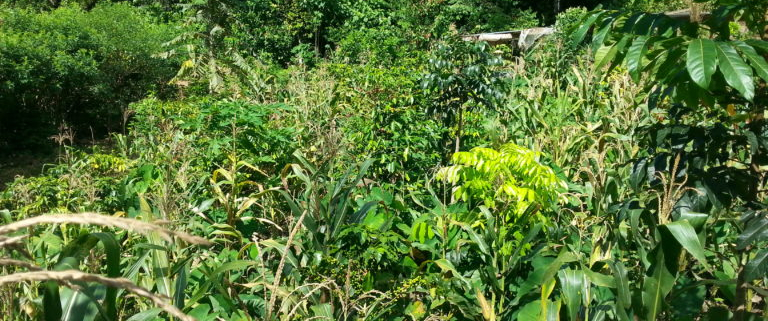
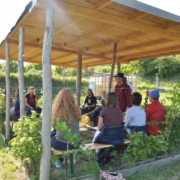
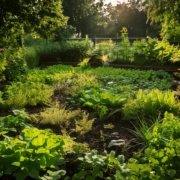 © Matthias Jünger (2023)
© Matthias Jünger (2023) 
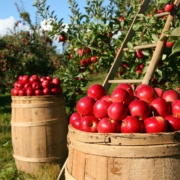
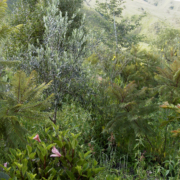
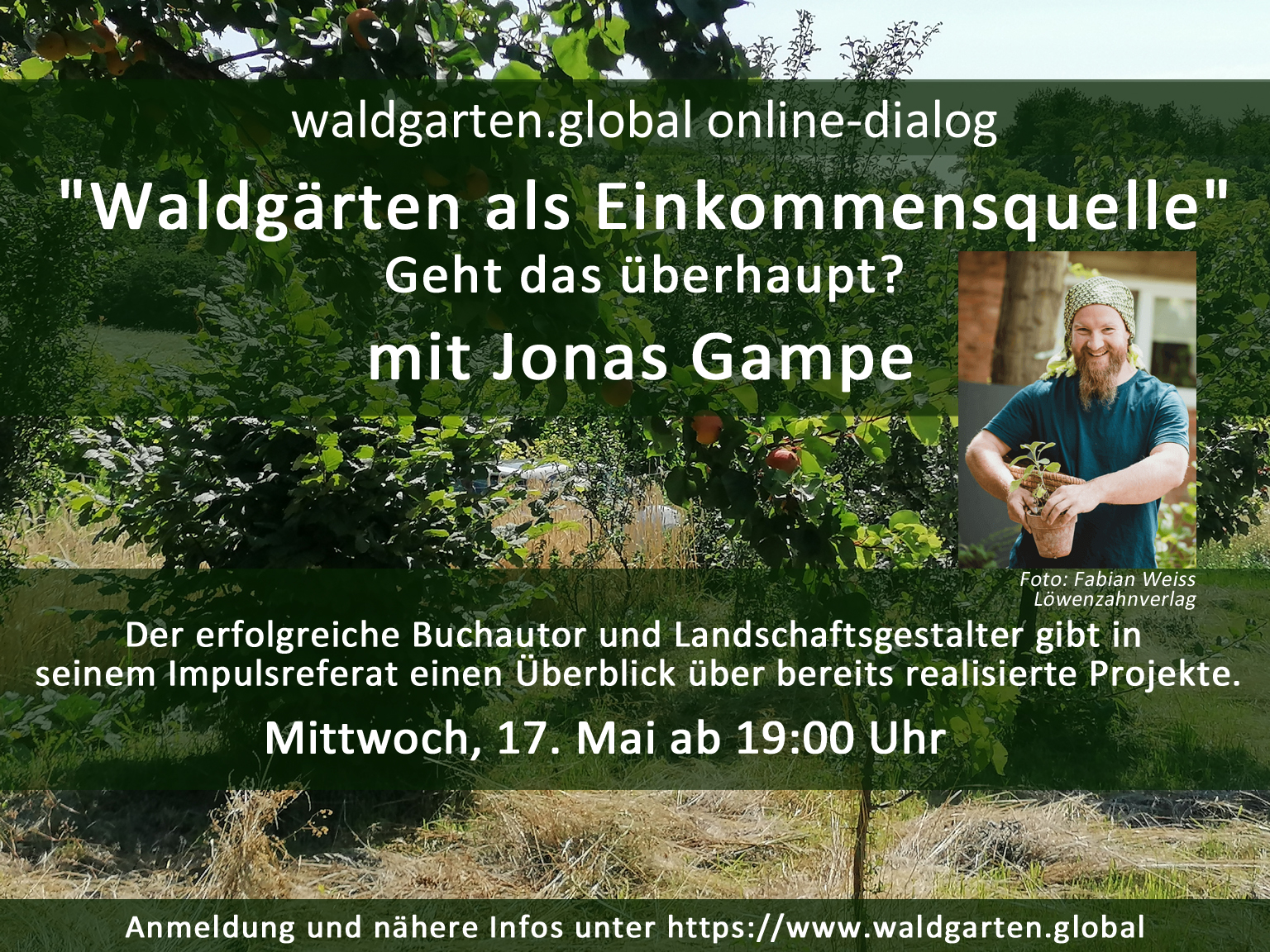
 Fotocredit Elisabeth-Scheidl
Fotocredit Elisabeth-Scheidl
Hinterlasse einen Kommentar
An der Diskussion beteiligen?Hinterlasse uns deinen Kommentar!